skip to main |
skip to sidebar
In the last few days I've made two trips to Coulsdon in Surrey for business meetings and it looks as if this may become a regular jaunt.
Click on any picture below for an 'uncropped' view.
Wolverhampton Station
Almost all my trips by rail start from Wolverhampton. I've always found the 'new' station building erected during electrification particularly dismal, so I've only just been persuaded to take a picture of the view which greets the passenger from the station approach road. All my Railway pictures around Wolverhampton station and in the West Midlands are here.
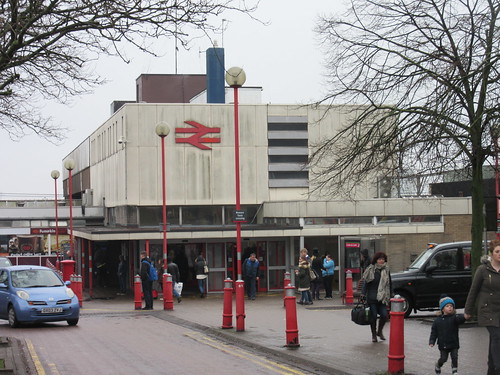 Wolverhampton Station.
Wolverhampton Station.
The depression that the sight of this uninspired building invokes is usually quickly compounded by a sense of being 'fleeced' when purchasing a ticket (although nowadays I sometimes buy tickets on the internet in advance). On both of my recent trips, I was travelling on the 06:04 departure to Euston and on each day Virgin did get me to Euston within a few minutes of right time.
Events of 14th January 2016
On the first of these trips, when I arrived at Euston I decided to take a Victoria Line train to Victoria. This proved to be a mistake as a signalling failure south of Victoria meant that southbound trains were only going as far as Victoria before reversing. Because of this, we were held for a few minutes at both Oxford Circus and Green Park to allow earlier trains to sort themselves out.
At Victoria, I lost no time in heading for the Brighton Line platforms and was on the move quite quickly to East Croydon with just one intermediate stop at Clapham Junction.
I knew that I had to change at East Croydon but, in theory at least, I might still have been earlier into my destination, Coulsdon South, than by travelling via London Bridge. However, the time lost on the Victoria Line ensured that this was not the case.
When my meeting was over, I walked back to Coulsdon South Station and, whilst waiting for my train back to London, I conducted a quick photographic survey. Of the 'bus shelters' on both platforms, the less said, the better. But the inoffensive brick station building on the Up side had been quite nicely renovated and the ticket office was staffed so, overall, I was quite impressed.
 Coulsdon South Station.
Coulsdon South Station.
One odd feature of the location of Coulsdon South station is the parallel Brighton main line a little over 100 yards away on which frequent fast trains (including the 'Gatwick Express' service) pass in both directions. This results from the rather curious origins of the history of these lines, outlined in Early railways around London below. The South Eastern Railway ended up sharing the London and Brighton metals to Stoats Nest (about one mile south of Purley station) then continuing on its own route through what is now Coulsdon South to Redhill.
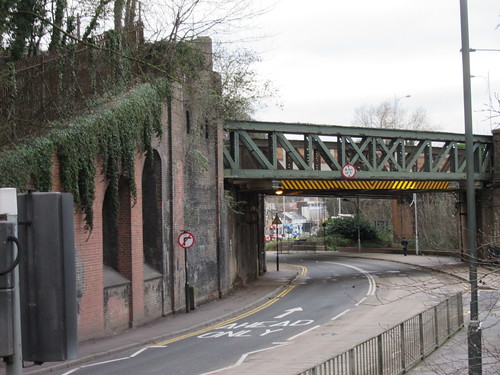 Bridge carrying the Brighton main line viewed from the road approach to Coulsdon South Station.
Bridge carrying the Brighton main line viewed from the road approach to Coulsdon South Station.
My train (a Bombardier 'Electrostar' Class 377) arrived on time and we made uneventful progress back to the still-being-rebuilt London Bridge, arriving at terminal platform 11.
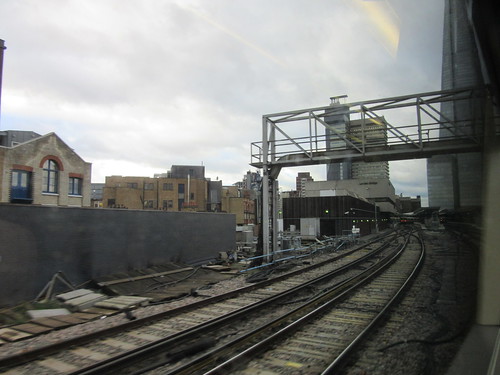 The rebuilt terminal platforms at London Bridge viewed from my arriving train.
The rebuilt terminal platforms at London Bridge viewed from my arriving train.
I wrote about the rebuilding of London Bridge in August 2015 in the post Visiting former 'Southern' stations in London and there's a suitably upbeat article from Network Rail about the project here.
The arched roof flanked by glazed bays which stood over the terminal platforms for more than a century has, of course, gone. Each rebuilt platform now has umbrella roofing supported on substantial, fabricated rectangular pillars. For some reason, the roof itself is wavy. It's probably not necessary to comment that it didn't appeal to me.
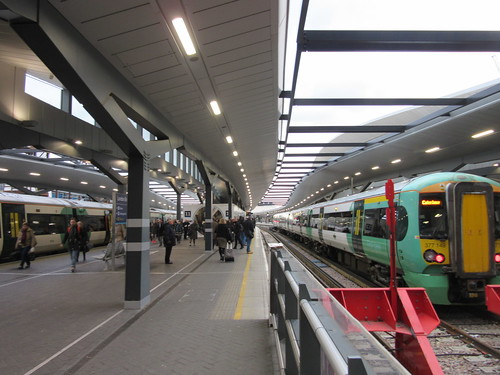 'Wavy' umbrella roofing on the terminal platforms at London Bridge.
'Wavy' umbrella roofing on the terminal platforms at London Bridge.
However, the airy, light concourse area is a distinct improvement on the muddle of the former arrangements. But development is not scheduled to be completed until 2018 so intrusive 'retail opportunities' may yet damage the effect. Network Rail excitedly refer to "the huge concourse, natural light ... bigger than the pitch at Wembley Stadium".
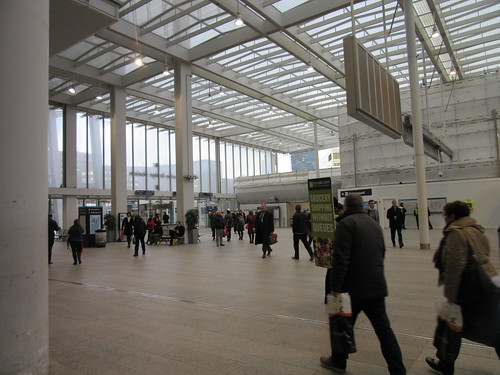 The new concourse at London Bridge.
The new concourse at London Bridge.
It's quite a walk to the Underground station and, on the way, 'London Bridge Vaults' already presents a host of 'retail opportunities'. The Northern Line then conveyed me back to Euston to catch a 'Virgin' service back to Wolverhampton.
Events of 28th January 2016
This time, on arrival at Euston, I took a Northern Line (City Branch) train to London Bridge which allowed me to join the 08:30 Horsham service and arrive at Coulsdon South just after 09:00 - a better result than on the 14th January.
When my meeting was finished, I caught the first train back to London. This was a 'Thameslink' service to Bedford, booked to call at East Croydon and Blackfriars, omitting London Bridge because of the continuing remodelling there. After the East Croydon stop, we sped past the massive Selhurst Depot.
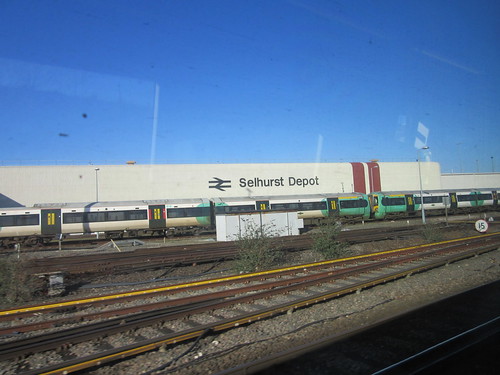 Selhurst Depot viewed from the Up London Bridge Fast.
Selhurst Depot viewed from the Up London Bridge Fast.
We passed through Norwood Junction and turned left onto the Up Crystal Palace Spur. At this point signalling control changed from Three Bridges Area Signalling Centre to Victoria Area Signalling Centre. The train continued through Crystal Palace, Gipsy Hill and West Norwood at a very sedate pace.
I realised that we were traversing the route I'd taken in the opposite direction on 12th February 2014. This trip was described in the post Industrial Action. On that occasion, I'd used the 'Thameslink' service because the 'Tube' was on strike but my train was diverted away from London Bridge because of a 'Signalling Failure'.
After West Norwood station, we took the Up West Norwood Spur, to reach Tulse Hill South Junction.
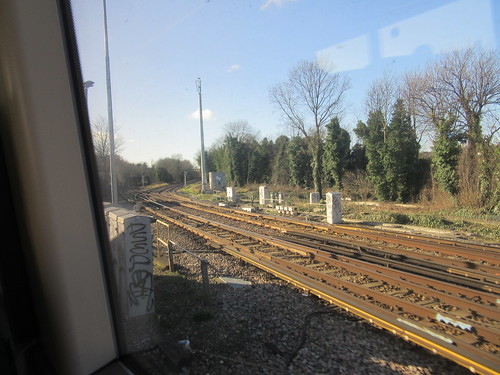 Tulse Hill South Junction, viewed from a train on the Up West Norwood Spur. The Portsmouth lines are in the centre, with the Leigham Spurs (leading to Balham) curving away to the right.
Tulse Hill South Junction, viewed from a train on the Up West Norwood Spur. The Portsmouth lines are in the centre, with the Leigham Spurs (leading to Balham) curving away to the right.
Having passed through Tulse Hill station, we continued our leisurely progress and turned left onto the Up Holborn line leading to Herne Hill. On my right, I was too slow to catch a picture of the splendid south portal of Knight's Hill Tunnel, but there's a little piece on the 'Southern E-Group' site here and a decent picture on 'Geograph' here.
At Herne Hill, the Chatham Lines joined on our right and, after the station, diverged on our left. Another mile took us to Loughborough Junction where the Brixton Spurs joined on the left, the Cambria Spurs joined on the right and we became four track through Elephant and Castle (Up and Down Holborn Slow, Up and Down Holborn Fast).
When we stopped at London Blackfriars, I was surprised when the driver shut-down the cab and restarted it. I wondered if some of the earlier slow running was related to a problem he was trying to clear. The re-built Blackfriars still offers views along the river. I was struck, once again, by just how ugly the re-development of Charing Cross station is (and it's up against some pretty stiff competition in London). At least the road side of the station and the concourse retains some dignity (see my picture album London Charing Cross Station).
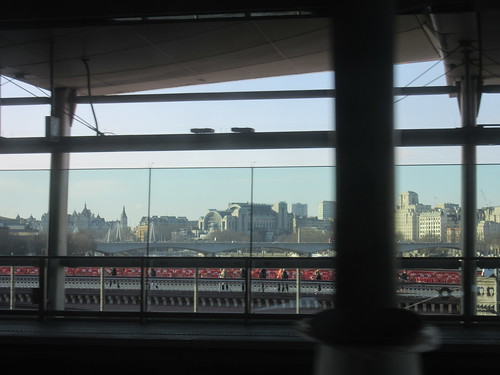 View from London Blackfriars station, looking upriver, with Charing Cross station in the centre.
View from London Blackfriars station, looking upriver, with Charing Cross station in the centre.
The train continued to the gloom of City Thameslink. After a brief pause, we carried on to Farringdon, passing the brightly-lit Smithfield Sidings on our left before entering the platform where the driver switched the dual-voltage train to receive a.c. current from the pantograph for the remainder of the journey. Our next stop was St. Pancras International, where I left the train. I'd not noticed before that the Overhead Line Equipment through the low-level platform features a solid aluminium extruded beam, rather than the usual Contact wire.
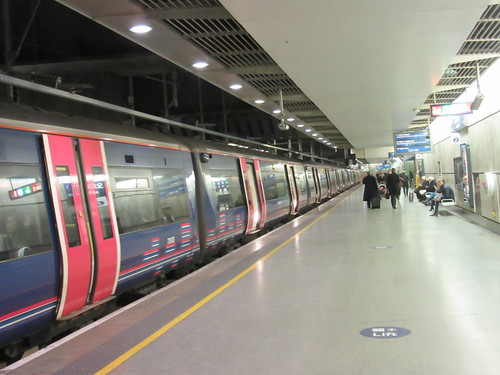 St. Pancras International.
St. Pancras International.
I walked to Euston and was able to catch a 'Pendolino' to Preston via Wolverhampton. I tend to travel in the 'Quiet Coach' which usually means walking the length of the train at Euston as Coach 'A' is normally at the 'country end'. I'm happy to report that, once again, we made a right-time arrival in Wolverhampton.
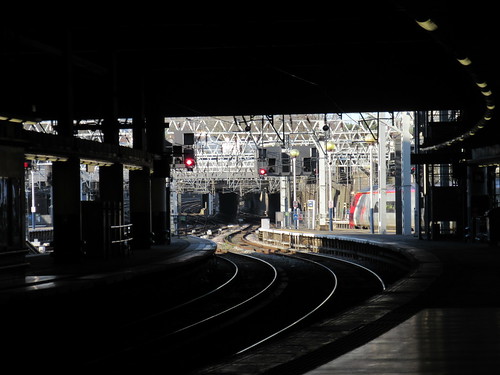 Euston: View from platform 7 looking towards Camden bank.
Euston: View from platform 7 looking towards Camden bank.
Early railways around London
The London & Greenwich Railway was opened throughout by 1838 with its London terminus at Tooley Street (now London Bridge). The following year, the London & Croydon Railway opened from West Croydon to a junction with the London & Greenwich Railway, sharing the Tooley Street terminus. In turn, the London & Brighton Railway opened throughout in 1841 from Brighton to a junction with the London and Croydon Railway, then sharing their lines to Tooley Street. The South Eastern Railway had obtained parliamentary approval for a line from London to Dover in 1836 but this railway was also to share the lines of the London & Greenwich Railway, the London and Croydon Railway and the London & Brighton Railway as far as Purley. Furthermore, the London & Brighton Railway was to build, at cost, the line on behalf of the South Eastern Railway from its junction with the London & Brighton Railway to Redhill. This line stayed quite close to the London and Brighton line and crossed under it to reach Redhill! After this rather tedious route out of London, William Cubitt then provided the South Eastern Railway with an almost dead straight main line from Redhill to Folkestone and Dover, with major intermediate stations provided with through lines for fast trains and platform loops for stopping trains.

Click on the map for a larger view.
1905 Railway Clearing House Map of lines in the vicinity of Coulsdon.
My pictures
These albums include pictures from these and earlier trips.
West Midland Railways.
London & Birmingham Railway.
London: former 'Southern' lines.
After 'Rocket' and 'Flying Scotsman' perhaps the best known locomotive is a fictional one - 'Thomas'.
BACKGROUND
'Thomas the Tank Engine' was created by the Reverend Wilbert Vere Awdry in 1946 as a character in the second book in his 'Railway Series' for children. The publishers engaged a professional artist to produce the book illustrations and the appearance of 'Thomas' was based on Billington's 'E2' class for the London, Brighton & South Coast Railway.
In 1979 Britt Allcroft arranged a deal to make the books into a television series which ultimately became popular all over the world as 'Thomas and Friends'.
Britt Allcroft saw the potential in video, toys and books and a franchising operation to exploit the 'Thomas Brand' was created. The Wikipedia post here has more information. It's believed that the Reverend Awdry became increasingly unhappy about the commercialisation of his creation. Britt Allcroft Company became Gullane Entertainment who sold the 'Thomas Brand' to HiT Entertainment after two years of wrangling. In 2005 Apax Partners acquired Hit Entertainment, selling the 'Thomas Brand' to toymaker Mattel in 2011 for a reported 680 million dollars.
Licensed Day out with Thomas events became popular on preserved railways in the U.K., as described in the section below, and in other countries but the increasing costs of mounting the event due to additional requirements imposed by HiT Entertainment resulted in many preserved lines discontinuing these events.
I'd not realised the extent of the interest in every aspect of 'Thomas' until I looked at the Sodor Island Fansite. There's all sorts of stuff out there - discussions of gender, race and class in the Reverend Awdry's work and forensic studies such as Henry the Green Engine.
'THOMAS' ON PRESERVED RAILWAYS
 'Thomas' at Shackerstone (Picture: The Sodor Island Fansite).
'Thomas' at Shackerstone (Picture: The Sodor Island Fansite).
Over the years, I have driven 'Thomas' many times but, whisper it, not always the same locomotive. 'Thomas' seems to share with Doctor Who the ability to regenerate in a variety of forms. It's always been a six-coupled side tank, painted blue with the number '1' on each tank and with a cheeky face on the front but otherwise, there have been differences.
Birmingham Railway Museum, Tyseley
My first opportunity to drive 'Thomas' came when I was a volunteer driver at Birmingham Railway Museum. Tyseley held occasional 'Thomas' events, with 'Richard III' posing as 'Thomas'. This locomotive was a large Robert Stephenson & Hawthorn (7537 of 1949) built for the British Electricity Authority (which later became C.E.G.B.). In 1972 it entered preservation at Shackerstone on what is now known as the Battlefield Line. There's are more details of the engine and its history by Chris Simmons here. I enjoyed driving this locomotive a few times but there were frequent problems with firebox leaks. One day, when George was driving 'Thomas' (I can't remember what engine I was on), he showed me the most spectacular leaks which had developed in the inner firebox (which was noticeably 'quilted') and that was the last steaming, I'm afraid. That must have been some time in the 1990s. 'Richard III' is now back at the Battlefield Line undergoing a very protracted restoration.

'Richard III' (Photo: C. Simmons)
Peak Rail
In the 1990s, Peak Rail ran 'Thomas' events. I was there for at least one 'Thomas' weekend but I wasn't rostered to drive and don't remember which 'Thomas' had been hired in. Peak Rail decided that the 'Thomas' event licensing conditions had become too financially arduous and discontinued 'Thomas' weekends.
Battlefield Line, February 2004
I can't remember when I first became involved with 'Thomas' at the Battlefield Line but the earliest pictures I've found are from 2004, in the collection Thomas, Shackerstone, February 2004 using 'Coventry No. 1' (North British Works No. 24564) - a big industrial 0-6-0 side tank.
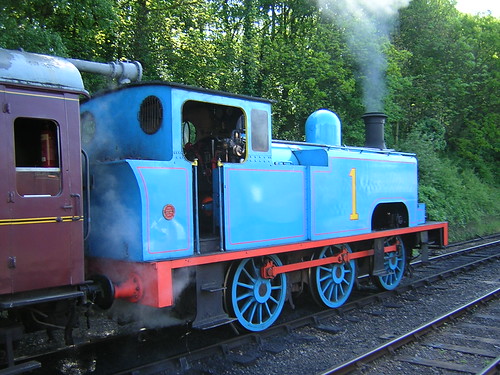 'Thomas' at the Battlefield Line in 2004 (formerly 'Coventry No. 1', North British works no. 24564.
'Thomas' at the Battlefield Line in 2004 (formerly 'Coventry No. 1', North British works no. 24564.
Battlefield Line, May 2005
This time, 'Thomas' had acquired outside cylinders and was celebrating his 60th Anniversary. There are a few pictures here.
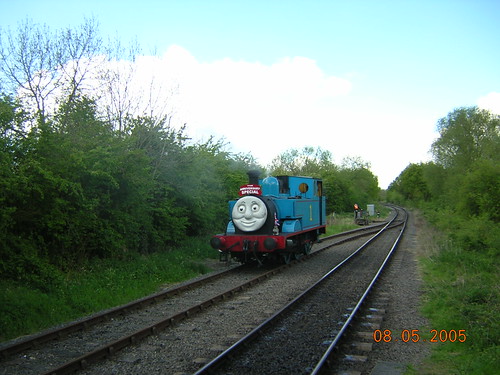 'Thomas' running round his train at Shenton.
'Thomas' running round his train at Shenton.
Battlefield Line, May 2006
This time, 'Thomas' was played by a 3F 0-6-0T originally built for the L.M.S. as '7298' by Hunslet Engine Co. Ltd. (Hunslet 1463 of 1924). Between 1924 and 1931 a total of 422 locomotives of this class were built (all but 15 by private builders). There's a Wikipedia article here. They were usually called by railwaymen a 'Standard Shunt' or a 'Jocko' but, for some reason I've never divined, they were called a 'Jinty' by enthusiasts and modellers.
 7298, posing as 'Thomas', shows her classic Midland lines and an odd paint job (of course, the Somerset and Dorset 'Standard Shunt' engines were blue at one stage, but not that shade).
7298, posing as 'Thomas', shows her classic Midland lines and an odd paint job (of course, the Somerset and Dorset 'Standard Shunt' engines were blue at one stage, but not that shade).
Battlefield Line, July 2007
I was re-united with 'Gothenburg' which I'd driven at East Lancs Railway many years before but the dignified dark green lined livery she'd had then was replaced by the cheerful blue of 'Thomas'. 'Gothenburg' was built by Hudswell Clarke and Company Limited (No. 630 of 1903) for the Manchester Ship Canal. All their locomotives were named after international seaports. For more information about this extensive railway system, see the book ‘The Railways of the Manchester Ship Canal’ by Don Thorpe (Oxford Publishing Co.) ISBN 0-86093-288-5.
There's a very short blog report here and my pictures of 'Gothenburg' are here.
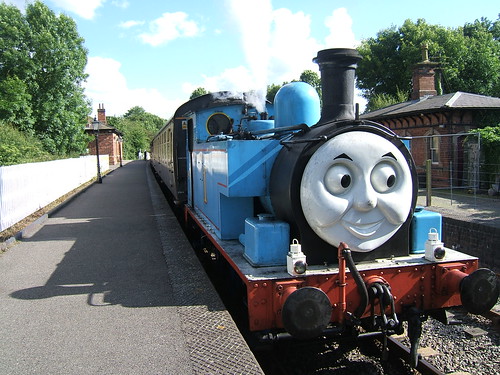 'Thomas' at Shenton ready to return to Shackerstone in July 2007 (actually Hudswell Clarke No. 630 of 1903 'Gothenburg').
'Thomas' at Shenton ready to return to Shackerstone in July 2007 (actually Hudswell Clarke No. 630 of 1903 'Gothenburg').
Battlefield Line, 2008
In the early part of the season, 'Coventry No. 1' (North British Works No. 24564) posed as 'Thomas'. In July 2008, I had a couple of days driving 'Thomas' at the Battlefield Line and one day in 'Daisy', the diesel multiple unit. There's a report on the 'Thomas events here and there are pictures here.
Between August and October, 'Thomas' had 'morphed again'. A Hunslet Engine Co. Ltd. six-coupled industrial (No. 1873 of 1937) had been very effectively converted from a saddle tank to a side tank (with extended side tanks, just like Thomas). Two 'splashers' had been fitted over the leading wheels (again, just like 'Thomas') but they were purely cosmetic because the small coupled wheels were well clear of the foot framing.
 'Thomas' (Hunslet No. 1873 of 1937).
'Thomas' (Hunslet No. 1873 of 1937).
In theory, the extended tanks help to maintain a useful water capacity whilst allowing the driver more space to clamber into the motion for oiling. Despite my smile in the picture below, I found it very cramped and uncomfortable.
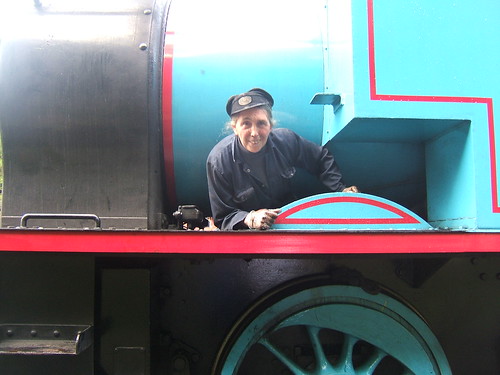 Preparing 'Thomas'.
Preparing 'Thomas'.
There's a report on the October events in a short post here (which includes a video) and there are pictures here and here.
Battlefield Line, 2009
During June 'Thomas' was played by '47327', an ex-L.M.S. 'Standard Shunt' from Midland Railway Centre and during October by Hunslet No. 1873 of 1937 (as in the previous year). There's a report here.
Battlefield Line, 2010
This time, 'Thomas' was celebrating his 65th Anniversary. Once again, ex-L.M.S. 'Standard Shunt' 47327 performed the role of 'Thomas' as shown in the reports here and here. There are pictures here and here.
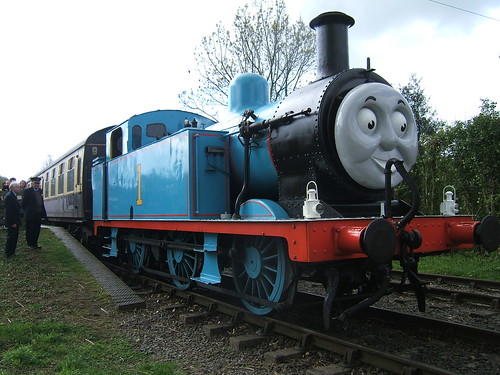 'Thomas' at Shenton, ready to return to Shackerstone on 3rd May 2010.
'Thomas' at Shenton, ready to return to Shackerstone on 3rd May 2010.
Battlefield Line, 2011
'Standard Shunt' '47327' returned as 'Thomas' for four days in June offering 'Day Out with Thomas' events. There's a report here and pictures here.
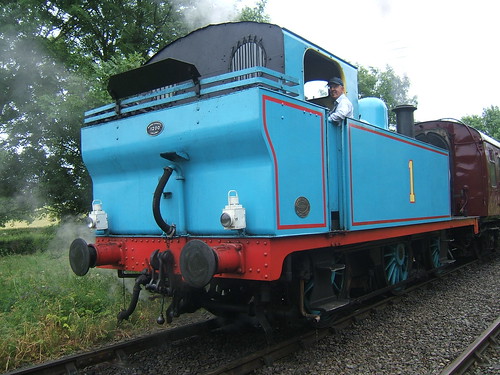 'Thomas' at Shenton, ready to return bunker-first to Shackerstone on 25th June 2011.
'Thomas' at Shenton, ready to return bunker-first to Shackerstone on 25th June 2011.
Museum of Science and Industry September 2011
MOSI first ran 'A Day Out with Thomas' events in 2010, whilst I was overseas. It was repeated in 2011 over four consecutive days, using 'Gothenburg' as 'Thomas'. I was the driver on 1st September 2011 and there's a report here with pictures here.
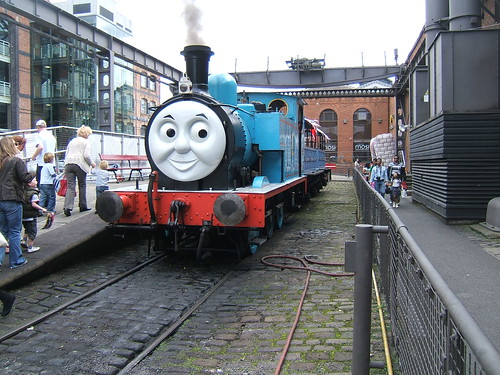 'Thomas' at MOSI in September 2011.
'Thomas' at MOSI in September 2011.
Battlefield Line October 2011
This time, 'Standard Shunt' '7298' returned as 'Thomas' for four days. I had one day driving 'Daisy' the Diesel Multiple Unit and one day driving 'Thomas'. There's a description in the post Day Out with Thomas: October 2011 and pictures are here.
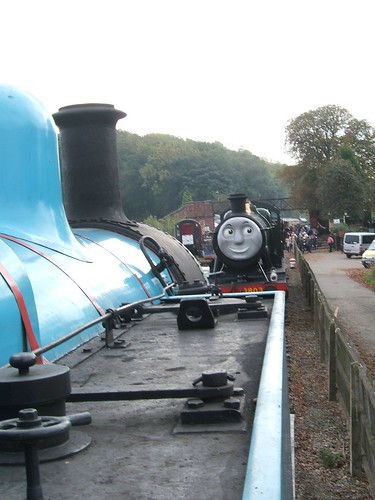
'Thomas' "head-to-head" with 3803 during shunting on 16th October 2011.
Battlefield Line May 2012
'Standard Shunt' '7298' was with us for the four days of the 'Thomas' event in April. On Sunday 22nd April I was on 'Daisy', on Saturday 28th April I was on 'Thomas' and on Sunday 29th April I was back on 'Daisy'. There are more details in the post 'Thomas' at the Battlefield Line.
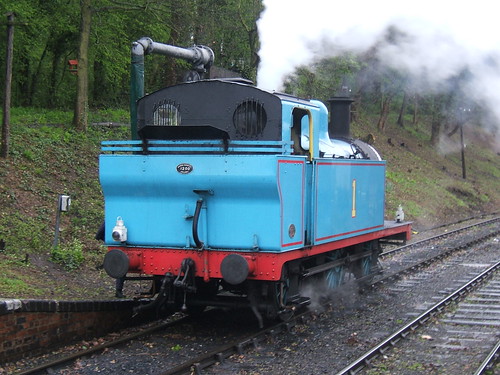 'Thomas' stands at the water column on platform 2 at Shackerstone.
'Thomas' stands at the water column on platform 2 at Shackerstone.
Museum of Science and Industry August 2012
'Standard Shunt' '7298' visited MOSI as 'Thomas' for a four-day event. There's a report here and there are pictures here. I think that was the last 'Thomas' event at MOSI and recently I believe all railway operations here have been suspended.
 'Thomas' with his 2-coach train.
'Thomas' with his 2-coach train.
Footnote
There's an 'Austerity' 0-6-0 saddle tank called 'Wilbert' after the Reverend Awdry who created the 'Thomas' stories. I drove this locomotive at Peak Rail's 'Balzing Saddles' event described here. There's more information about 'Austerity' 0-6-0ST locomotives and 'Wilbert' here.
Summary of posts of 'Thomas' events on this website
You can find all my reports about 'Thomas' events here but I've listed these reports individually below:-
'Gothenburg'.
Day Out With Thomas 2008.
Day Out with Thomas.
Day out with Thomas: 2009 Battlefield Line, October 2009.
Happy Birthday, Thomas! Battlefield Line, April 2010.
Happy Birthday Thomas! (part 2) Battlefield Line, June 2010.
Day Out With Thomas - June 2011 Battlefield Line, June 2011.
'Thomas' visits MOSI MOSI, September 2011.
Day Out with Thomas: October 2011 Battlefield Line, October 2011.
'Thomas' at the Battlefield Line Battlefield Line, May 2012.
Day out with Thomas at MOSI MOSI, August 2012.
Summary of my albums of pictures of 'Thomas' events
Thomas, Shackerstone, February 2004.
Thomas, Shackerstone, 2005.
Day out with Thomas, October 2008.
Hunslet Works Number 1873 (as 'Thomas'.
2009-10-10 Thomas and Friends: 2009 (Oct 2009).
Thomas at 65 (Battlefield Line May 2010).
Thomas, Shackerstone, October 2010 (Battlefield Line).
'Thomas' - June 2011 (Battlefield Line).
'Thomas' 2011 (Battlefield Line).
Thomas at MOSI (2011).
Day Out With Thomas: October 2011 (Battlefield Line).
Day Out With Thomas: April 2012 (Battlefield Line).
Thomas at MOSI (2012).
Another wonderful year for which I'm very grateful. The notes below are not comprehensive, they just outline more memorable events.
OVERSEAS TRAVEL
There is an alphabetic list of most of the countries I've visited in the post Jan Ford's Travels: Around the World in pictures, with links to each country's pictures.
Singapore to Sandakan aboard the MS Caledonian Sky
I left home on the 24th January 2015, travelling from Birmingham Airport to Singapore (with a transit in Dubai) using Emirates. After a comfortable night at the Shangri-La Hotel, I joined the 100-odd fellow passengers on the Noble Caledonia party for a tour of the city by coach and river boat, including the famous Botanic Gardens before finishing at the airport for our overnight Air Niguini flight to Papua New Guinea. We first had a 'day-room' at the Crowne Plaza hotel before a bus tour of Port Moresby which included a brief visit to the impressive National Parliament Building. We were then made very welcome at the Country Park before being taken to our ship 'Caledonian Sky'.
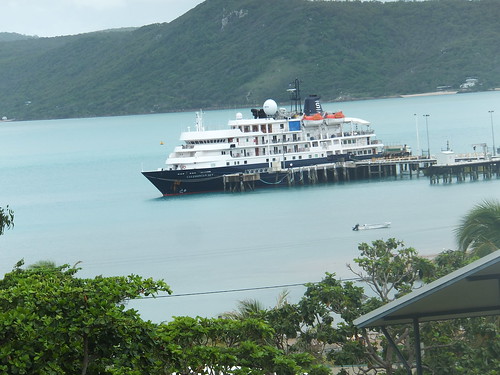 'Caledonia Sky' visits Thursday Island, Australia.
'Caledonia Sky' visits Thursday Island, Australia.
During the first day on our well-appointed ship, we sailed across the Coral sea to reach Thursday Island (called 'TI' by residents) which is part of Australia, lying north of Queensland. A coach took us on a tour of the western part of the island then, after lunch, I walked around the eastern part of the island. I found it all fascinating. The whole of the next day we sailed across the Arafura Sea back to the New Guinea land mass but further west to the Asmat region which is part of Indonesia. We went ashore at Syuru by 'Zodiacs', met by around 40 canoes with fierce-looking, chanting native people who were fortunately friendly. We first watched traditional ceremonies for the launching of four new dugout canoes before walking through the local village of rather primitive buildings to reach the slightly more modern town of Agats, where our Zodiacs picked us up and took us back to the ship. The next day, following an early morning 'Zodiac' trip to see the mangroves and nipah palms, we sailed for Triton Bay, arriving the following day. In the morning, the 'Zodiacs' took us around some of the limestone pillars forming small islands, in the afternoon we landed at a sandy beach before sailing overnight for Andamatta. 'Zodiacs' took us to see the prehistoric rock paintings then the ship moved to Kokas where we landed at the more modern village by 'Zodiacs'. We were entertained by a series of dances outside the school and there was time to wander among the friendly Indonesian people before returning to the ship. Overnight, we sailed to the Boo Archipelago. At Torobi Island, a nature cruise by 'Zodiac' in the crystal-clear waters revealed a little of the magical world of the coral reef below the surface. In the afternoon, we landed on the tiny island of Pulao Boo with its white beaches of crushed coral. Swimming was curtailed as the sea became rougher, but there was time to walk right around the island before returning to the ship.
Our next destination was Ternate in the Molucca Islands but, before we arrived, there was a 'Crossing the Line' ceremony with King Neptune and his entourage where passengers who had not previously crossed the equator by ship were invited to 'Kiss the Fish'. Ternate was the largest community we'd seen since joining the ship. Coaches took us to a fascinating visit at the Sultan's Palace, a Lava Field left by a previous volcanic eruption of Mount Gamalama, the ruins of Portuguese-built Fort Tolucco, the former home of naturalist Alfred Russel Wallace and finally the Market. We sailed overnight to Sulawesi, another Indonesian Island (originally called 'Celebes' by the Portuguese). We docked at Bitung, an important port with a population exceeding 200,000. Once ashore, modern coaches took us to the nearby Fish Dock, the Local Market then the village of Sawangan where pupils at a Christian school sang for us. Nearby, we were given refreshment whilst performers sang and danced. The coaches took us back to the ship for lunch after which an hour's drive took us to the Tangkoko Nature Reserve to see the rare Spectral Tarsier monkey.
Overnight, we cruised to Bunaken Island, Sulawesi. The Marine Reserve here is one of the most important in the world and our 'Zodiac' cruise provided spectacular views of the coral reef. Around 1.00 p.m. we set off for Toli Toli, Sulawesi, our last port of call in Indonesia, which we reached around noon the following day. Tricycle rickshaws took us into town, where we looked at the Market. A mixture of public and Police coaches then took us to a former Sultan's house, now a museum, where tents and seating had been arranged for us to watch a 'cultural performance'. We were then taken in convoy to the Mayor's Restaurant for refreshments and entertainment by a 'Bamboo Band' and a modern 'Sing Along'. Impressed and exhausted, we returned to our ship.
We cruised through the night, then the whole of the following day and night before arriving at our final port, Sandakan on the island of Borneo. Sandakan, with a population around 400,000 is in Sabah, part of Malaysia. On leaving the ship, coaches first took us to Sandakan Memorial Park which commemorates the allied prisoners of the Japanese who died here during World War II. Next we visited the reconstructed house of American author Agnes Keith, who survived internment by the Japanese. Finally, we visited Sepilok, home of the world-famous Orangutan Rehabilitation Centre and, more recently, the Bornean Sun Bear Conservation Centre before enjoying the comforts of the Four Points by Sheraton hotel overnight. Most of the passengers travelled to Kuala Lumpur on the same flight, transiting to a London flight. I travelled with them as far as Kuala Lumpur and then by Emirates back to Birmingham.
It was a memorable trip. There are 22 posts describing the whole voyage. You can find them all here, with links to pictures for each country visited. Pictures of the ship are here.
Trip to Burma
On the 17th April, I flew from Manchester to Yangon, via Doha, by Qatar Airways. Dr. Hla Tun met me on arrival in Yangon and in the evening, in a party including Emily, a young medical student from U.S.A. we drove south to Mon State and spent a few days visiting Drop In Centres forming part of the Orphans and Vulnerable Children Project. Our return to Yangon proved more exciting than expected as our car was hit by another vehicle and badly damaged. Fortunately, nobody was hurt but we were delayed awaiting a replacement vehicle to complete the journey. After a night at Dr. Hla Tun's house, on Friday, 24th April Emily and I flew with the Doctor to Nyaung Oo and then on to Bagan Medical Clinic by car. I spent Friday, Saturday and Sunday studying the work of the Clinic then on Monday Dr. Hla Tun and I, together with two newly-qualified doctors and the parents of one, visited the schools at Chauk Kan and Htee Pu. Later that day, the Doctor and I flew back to Yangon.
The next day, I flew with a guide to the north of Burma, to Putao in Kachin State which overlooks the snow-covered mountains of the Himalayas. I spent an enjoyable few days seeing a little of this very different area, staying at 'Putao Trekking House' which was a very well-appointed and hospitable hotel. The tour included a 10-mile trek to Nang Kham village where a Guest House was opened especially for my overnight stay.
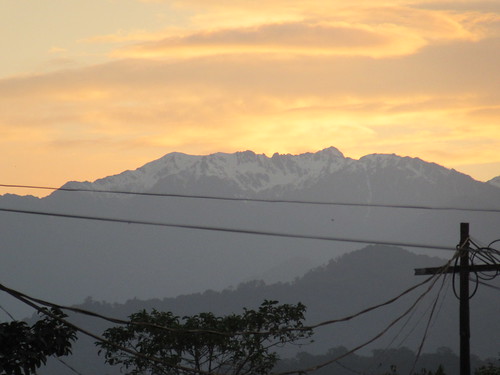 Putao: view of snow-topped mountains at sunset (sorry about the electric cables).
Putao: view of snow-topped mountains at sunset (sorry about the electric cables).
I flew to Mandalay, explored the city (and its railways), and made a pleasant visit to Mingun with my friend Htein Lin and his family. Before flying back to Yangon, I met my friends Ko Hlaing and Ma Khaing with their vivacious young daughter.
Back in Yangon, I explored a little on foot and made a couple of railway journeys around the city. I accompanied the Doctor on Orphanage visits organised by 'Pencils for Kids Inc.'. The Doctor had also arranged visits to the diesel locomotive depot at Mahlwagon and the locomotive works at Insein. Another amazing trip to this fascinating country!
My first trip report is here, with a link to the next post, and so on. All reports on this trip are here. Each post has links to related photographs. All my pictures on the trip are here (railway pictures have been added to the collection Railways in Burma).
TRAVEL IN THE UK
During the year I made a few trips (mainly by rail) to various destinations, some of which have blog posts.
Irlam Station
On 28th March, I attended the official re-opening of the restored station building at Irlam. My journey by rail is described here and the re-opening here.
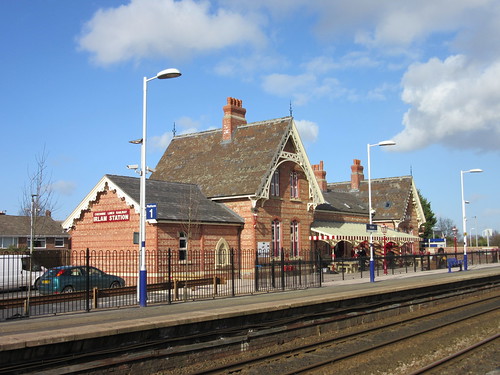 Irlam Station Launch: The restored building viewed from the Down platform.
Irlam Station Launch: The restored building viewed from the Down platform.
By Rail to Guildford
I travelled to Guildford on 8th August for the OLCO 'Lionsmeet'. My journey by rail is described here.
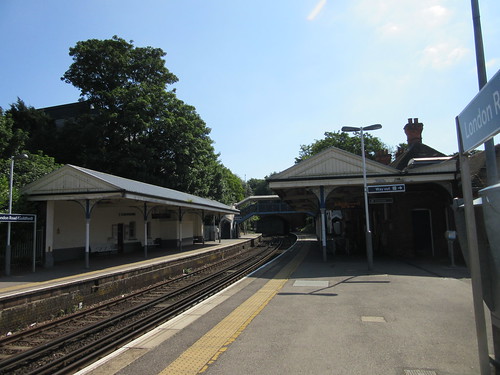 London Road (Guildford).
London Road (Guildford).
Visiting former 'Southern' stations in London
On Friday 21st August, I was in London for a meeting and found time to look at a number of former 'Southern' stations, described here and in the post Waterloo Station, London (Part 2)
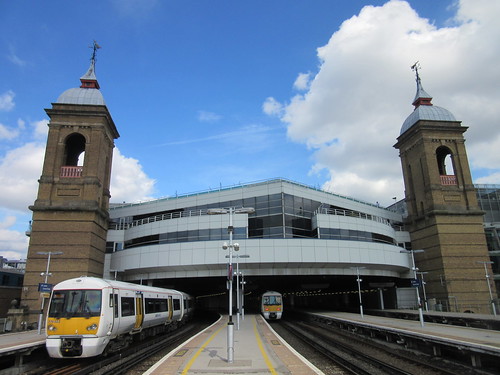 London Cannon Street Station.
London Cannon Street Station.
Liverpool via Preston
On Saturday 17th October, I travelled by train to Crewe (taking a few pictures outside the station) then on to Preston. This journey is described in the post Wolverhampton to Preston by rail). Then I caught the train to Ormskirk, changed to a 'Merseyrail' service and continued to Liverpool where I visited the Museum of Liverpool, made the (inevitable) Mersey Ferry journey to Birkenhead Woodside, took the train to Conway Park and then returned to Liverpool, this time by electric train through the tunnel. There's a post on this part of the day here.
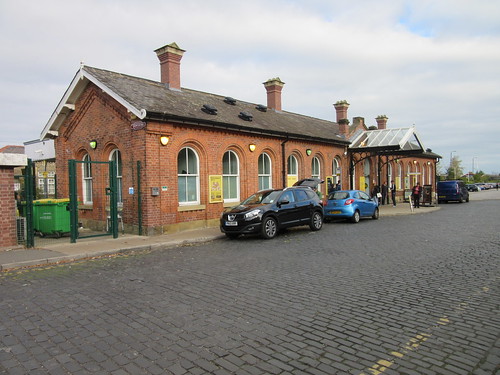 Ormskirk station building from the road side.
Ormskirk station building from the road side.
Merseyside in December
On 29th December, I decided at the last minute to make a trip to Liverpool. Changing at Crewe, I took more photographs of the station buildings and overall roof before continuing to Liverpool on the 'London Midland' service. I made the customary pilgrimage to the locomotive 'Lion' in the at the Museum of Liverpool. I then took the ferry across the river but the sun was so unexpectedly shining that I disembarked at Seacombe and walked to New Brighton, by which time I was happy to return to Birkenhead Hamilton Square by train. I then walked to Woodside Ferry Terminal and studied the full-size replica of the 1879 submarine 'Resurgam' before returning to Pierhead by ferry, giving an opportunity to look at the Cammell-Laird Shipyard. From Pierhead, I walked to James Street, took the 'Merseyrail' train to Lime Street and boarded the 'London Midland service homewards. The good weather helped to make this a splendid trip, described here.
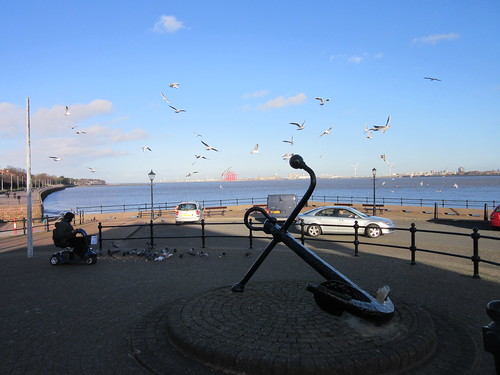 The Wirral: The Promenade from Seacombe to New Brighton at Egremont, looking seawards.
The Wirral: The Promenade from Seacombe to New Brighton at Egremont, looking seawards.
RAILWAYS AND PRESERVATION
During 2015, I continued to support the Old Locomotive Committee and remained an active volunteer at The Battlefield Line and Peak Rail.
The Old Locomotive Committee
On Saturday, 30th May, the OLCO Annual General Meeting was held in the Museum of Liverpool Museum. There's a report here.
In 2015, 'Lionsmeet' was hosted by Guildford Model Engineering Society at Stoke Park, Guildford. My report is here.
You can find all my posts about OLCO here.
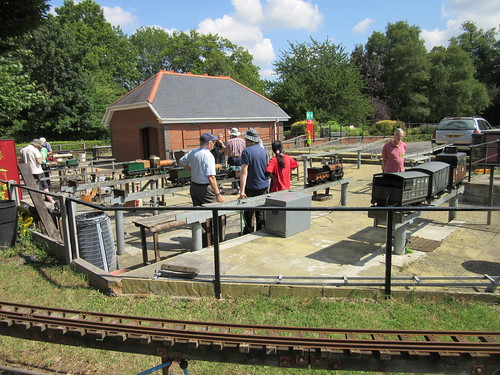 Lionsmeet 2015: Looking across the steaming bays towards the Carriage Shed.
Lionsmeet 2015: Looking across the steaming bays towards the Carriage Shed.
The Battlefield Line
On Easter Saturday 4th April, I was booked out on '3803' with Dave as fireman. The day proved more eventful that expected: a spring hanger on the tender broke. We limped home and, whilst Adrian effected a temporary repair, we made one round trip with the Diesel Multiple Unit. The last trip was back to steam operation. There's a report here.
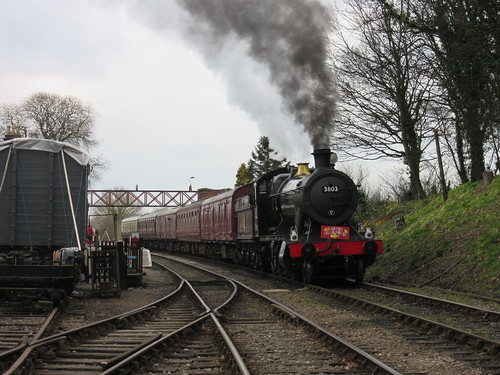 3803 back on its train for the final round-trip of the day.
3803 back on its train for the final round-trip of the day.
I was driver on the diesel railcar on a number of dates during the year. There's a post here describing my 'turns' in June and July.
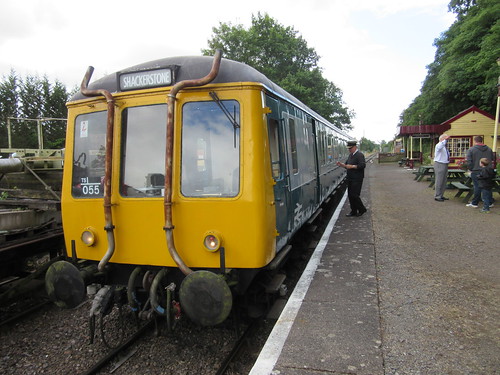 Midweek 2-car Heritage Railcar, 21st July 2015.
Midweek 2-car Heritage Railcar, 21st July 2015.
The Battlefield Line held a Steam Gala on the weekend of 23rd, 24th and 25th October with four locomotives in steam. I drove 'Austerity' saddle-tank 'Cumbria'. We operated a double-headed demonstration freight train with 'Sir Gomer' followed by the 12 o'clock and 3 o'clock passenger trains, as described here.
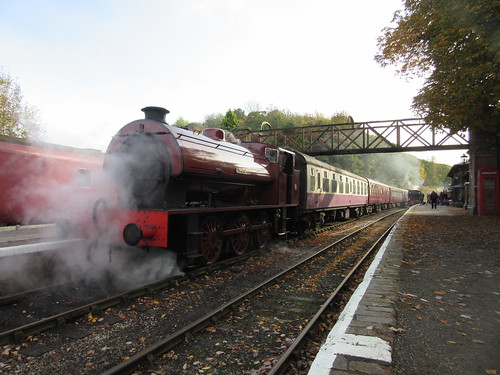 Battlefield Line Steam Gala, October 2015: 3794 'Cumbria'.
Battlefield Line Steam Gala, October 2015: 3794 'Cumbria'.
In December, I had two driving turns on the 'Santa' trains. On Saturday 19th December, I drove 'Cumbria', as described here. I was back on Wednesday 23rd December, this time on the 'Collett Goods', as described here.
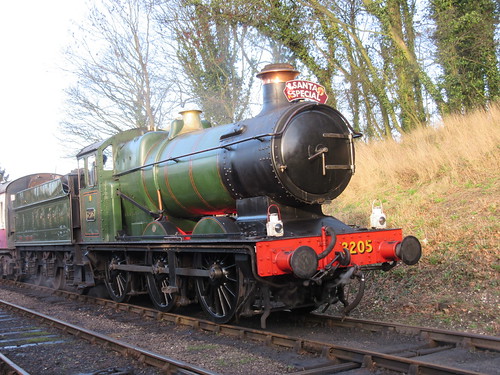 Battlefield Line 'Santa' Train hauled by '3205'.
Battlefield Line 'Santa' Train hauled by '3205'.
Peak Rail
In January and February Peak Rail operated a Winter Timetable where 'Lord Phil' worked the service between Rowsley and Matlock Riverside, running round at each end. My first turn of the year was cancelled because of locomotive failure but, on Sunday 22nd February, I operated the winter service with Dave R. (fireman) and Jacob S. (cleaner). The weather was rather mixed but we all enjoyed the day. A week later, the 'Main Season' timetable commenced, involving 'Top and Tail' working to Matlock Town with a diesel electric at the other end our. Phil M. was fireman and, once again, Jacob S. we cleaner. This time, the weather was foul, which encouraged me to title the report on the day Rain, Sleet and Snow.
My next turn was on Saturday 21st March, again with Dave R. Unfortunately, both injectors were playing-up, but we agreed to perform the two 1-hour driving experience courses. Then we discovered the 'brown tank wagon', from which we replenish the saddletank, was empty. Gordon B. (driver of 'Penyghent' at the other end of our train) and I agreed that that simplest solution was to swop the engines round so that we were at the north end and able to water from the 'grey tank wagon'. Well, it was a bit of a struggle with two troublesome injectors but we ran the service, as described in the post here. This was the last public appearance by 'Penyghent' until scheduled repairs are completed.
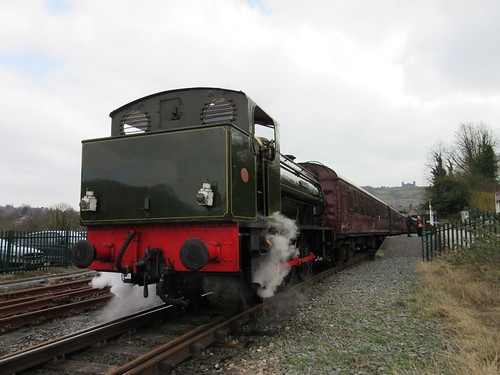 'Lord Phil' at Matlock, ready to haul the service train back to Rowsley on 21st March 2015.
'Lord Phil' at Matlock, ready to haul the service train back to Rowsley on 21st March 2015.
On Sunday, 12th April 2015, Rowsley was the destination for a Pathfinder Tours railtour operated by two 'Class 20' called 'The Dimple, Darley and Dale'. I was driver on 'Lord Phil' operating the Peak Rail passenger service to a modified timetable, to leave a path for the railtour to arrive an depart, as described here.
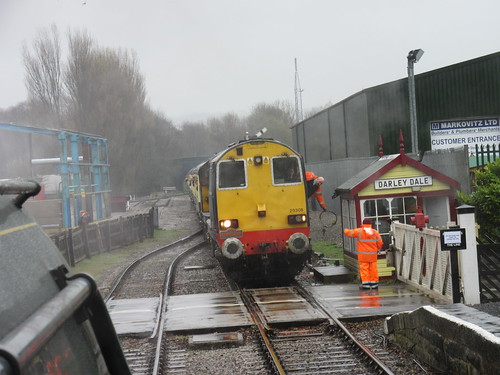 The Pathfinder Railtour passing Darley Dale en route to Rowsley.
The Pathfinder Railtour passing Darley Dale en route to Rowsley.
The Peak Rail Preserved Bus Gathering was held on Sunday 21st June with 64 preserved buses attending! I was, again, driver on 'Lord Phil'. The post here has more information.
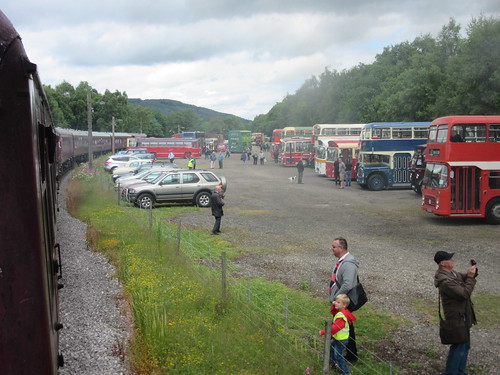 Peak Park Preserved Bus Gathering 2015: 'Lord Phil' sets off for Matlock.
Peak Park Preserved Bus Gathering 2015: 'Lord Phil' sets off for Matlock.
The Peak Rail 1940s Weekend was on 1st and 2nd August. I was driver with Dave P. fireman on Sunday 2nd August with a 7-coach train. The 'Class 31' was at the south end and 'Lord Phil' at the north end, which gave a bit of variety. My report is here.
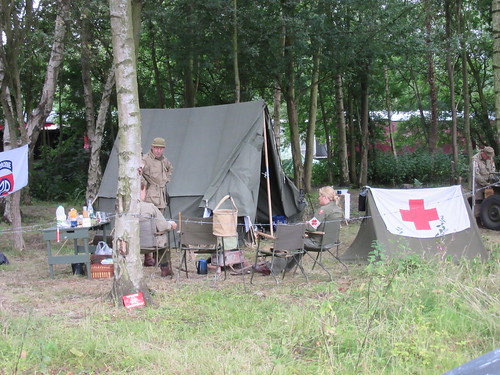 Peak Rail 1940s Weekend, 2015.
Peak Rail 1940s Weekend, 2015.
I had two driving turns on the 'Santa' trains in December. The report for Sunday 6th December is here and that for Sunday 20th December is here.
 Peak Rail - Christmas 2015: A choir from Matlock Musical Theatre performed on the platform at Rowsley.
Peak Rail - Christmas 2015: A choir from Matlock Musical Theatre performed on the platform at Rowsley.
Myanma Railways
During my 'Trip to Burma' (see above) I spent some time studying this little-understood system. In Mandalay, I took more pictures around the main station and found out more about the Ywa Taung Locomotive Workshop (there's a post here). Back in Yangon, I explored on foot and made a couple of railway journeys around the city (see posts Yangon (Part 1) and Yangon (Part 2)).
Doctor Hla Tun had kindly arranged visits to the Mahlwagon Marshalling Yard and Diesel Locomotive Shed (post here) and the locomotive works at Insein (post here).
All my posts on railways in Burma can be found here.
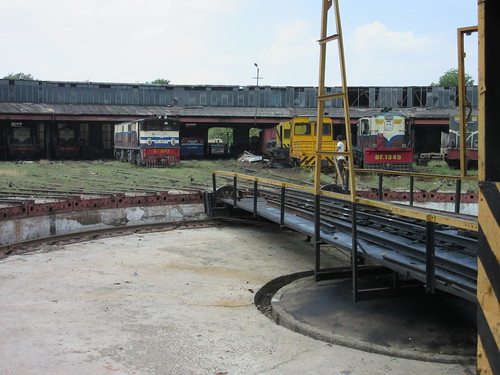 Mahlwagon Diesel Shed and Turntable.
Mahlwagon Diesel Shed and Turntable.
TY GWYN
The agreed harvesting was completed early in 2015 and 'Ground Preparation' was carried out prior to re-planting. This was the situation when I visited by car with Ann and Dean on 6th June. On 26th November, I made another visit a few days after re-planting had been completed (this time travelling by train to Wrexham) to discuss the maintenance programme with the forester, Rob MacCurrach. There are pictures here.
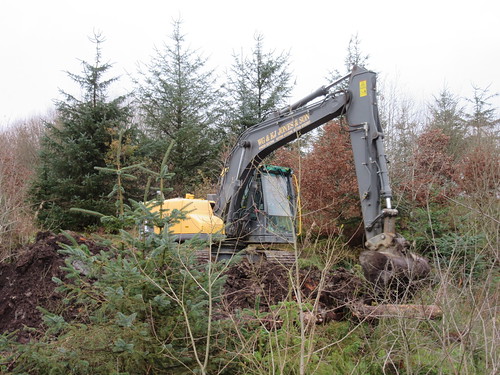 Ty Gwyn, November 2015: Maintenance work around the Pool.
Ty Gwyn, November 2015: Maintenance work around the Pool.
BREWOOD HALL
The Brewood Garden Party was held at Brewood Hall for the third time on Saturday 11th. Once again, we were lucky with the weather. There's a report here.
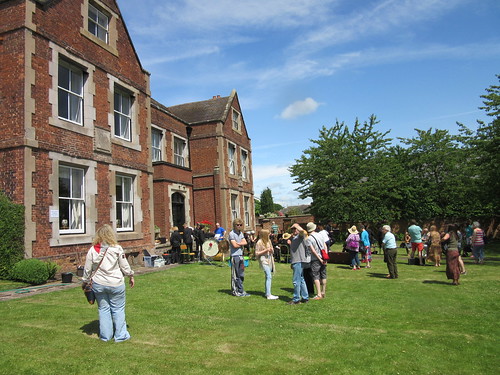 Brewood Garden Party 2015.
Brewood Garden Party 2015.
Following interest expressed by a number of people attending the Garden Party, pre-booked tours of the principal rooms of Brewood Hall were arranged for the 3rd and 4th October, as described in the post Tour of Brewood Hall, 2015.
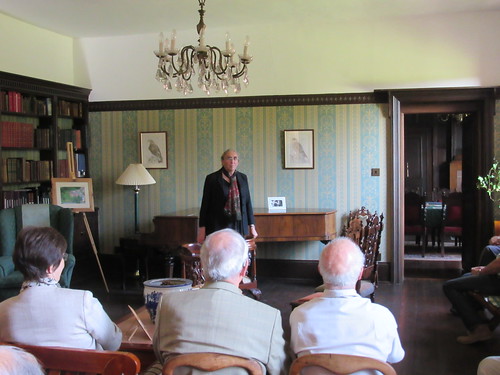 Brewood Hall tour, 4-Oct-2015.
Brewood Hall tour, 4-Oct-2015.
The informal Railway Group met once on Thursday 21st May. There's a short report here.
 Railway Group session at Brewood.
Railway Group session at Brewood.
'ROAD TO MANDALAY' SOCIAL CONTRIBUTION
For a number of years, I've supported the charitable initiatives operated under the above name in Burma. When I visit Burma, I try to see as much as possible of the work in hand. The charity provides Educational Support to a range of schools and orphanages (including the Orphans & Vulnerable Children Project in Mon State) and Medical Treatment to all ages (centred on the wonderful Bagan Medical Clinic). You can find my posts on Educational Support here and those on Medical Treatment here.
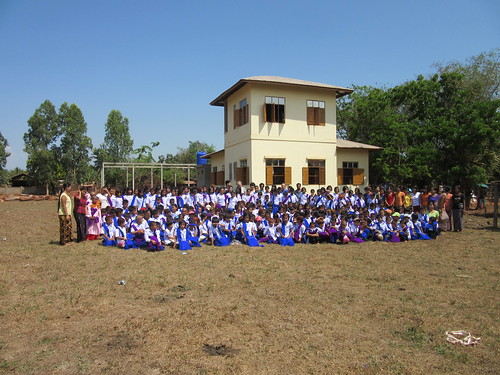 Group photograph at Ko Dut Drop In Centre: Monday 20th April 2015.
Group photograph at Ko Dut Drop In Centre: Monday 20th April 2015.
PREVIOUS ANNUAL REVIEWS
2014
2013
2012
2011
2010
2009
2008
2007
2006
When I was young, my family started the tradition of having a day out by car on Boxing Day or thereabouts. My choice was always somewhere 'inappropriate', usually the seaside. We had more than one picnic in snowstorms. The idea still appeals to me but nowadays it's usually a trip by train, once our national rail network resumes some sort of service after the inevitable (and often over-running) major engineering works.
Events of 29th December 2015
In 2015, Christmas day fell on a Friday, so the official Boxing Day holiday was moved to Monday, 28th December. Bus and rail services were expected to resume on the following day but I thought it might be safer to defer any trip until Wednesday. However, following a wet, overcast and windy Boxing Day where I live (there had been serious floods in parts of the country), Tuesday was dry and wind-free so, on the spur of the moment, I left my home to catch the first bus of the day to Wolverhampton. Somewhat to my surprise, the bus arrived on time and made good progress to Wolverhampton.
I walked from the bus to the railway station (which is often now called the 'train station' - an Americanism I'm not fond of). Although I had an idea of my preferred destination, I asked the fares to three different places but, since the Booking Clerk knew me, she did not find the multiple enquiries unexpected. Whilst I understand a little about railways, the various ticket prices and restrictions which apply nowadays tend to defeat me. I sometimes book tickets on the internet but I always retain the suspicion that there is a better fare, if only I could work it out.
Regular readers will not be surprised at my decision to purchase a return ticket to Liverpool - it's a city which always attracts me and, if the weather became poor, there would be plenty of things to see indoors.
There was about 15 minutes to wait before the direct service but I was in time to board the earlier 'Virgin' 'Pendolino' service to Edinburgh, changing at Crewe. When running correctly, I admit to being impressed by the 'Pendolino' trains. We made the non-stop journey to Crewe in just over 30 minutes.
Crewe
Of course, on arrival at Crewe, I had to wait for the following 'London Midland' direct service to Liverpool to arrive but I'm always happy to wander round the station, principally looking at the architecture.
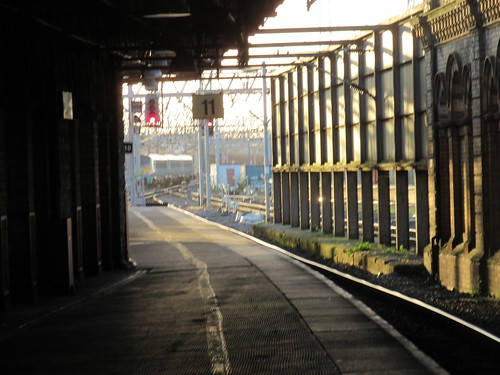 Crewe Station: View from platform 11 (former platform 3) looking south, showing LNWR screen. An 'Arriva Trains Wales' DMU is departing for Shrewsbury.
Crewe Station: View from platform 11 (former platform 3) looking south, showing LNWR screen. An 'Arriva Trains Wales' DMU is departing for Shrewsbury.
There are a number of earlier posts on Crewe, such as Crewe Station. There are also two collections of pictures which get added to from time to time Crewe Station Buildings: L&NWR and Crewe Area rail.
The 'London Midland' service to Liverpool arrived about 5 minutes late - the usual 4-car 'Desiro' Electric Multiple Unit. By the time all the waiting passengers had boarded, there were only a few seats left empty.
Crewe to Liverpool
We set off for Liverpool, stopping at Winsford, Hartford, Runcorn and Liverpool South Parkway. It's fairly hopeless trying to take pictures from modern trains with double-glazed windows and brightly-lit interiors but the collection Liverpool area rail has a number of pictures taken between Crewe and Liverpool.
On this journey, as we crossed the Dutton Viaduct over the River Weaver, the sky was blue and the sun was shining, making it hard to believe it was December and I decided I might have picked the right day for my trip.
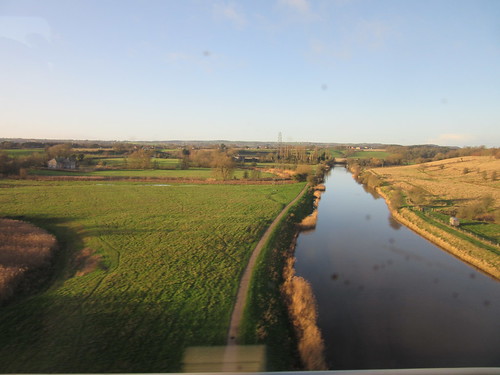 The view west as we crossed the River Weaver on the Dutton Viaduct.
The view west as we crossed the River Weaver on the Dutton Viaduct.
At Weaver Junction, we left the West Coast Main Line to the north, diverging onto the Liverpool Line. The gradient diagram from Weaver Junction to Liverpool Lime Street is reproduced below. In steam days, firemen could be anxious as to whether they'd be able to generate sufficient steam to get over the next summit and then be able to re-fill the boiler. With powerful modern electric trains, the profile of the line is of less importance, although it's still necessary to understand how the gradient will affect braking at any point on the route.

Gradient diagram Weaver Junction - Liverpool Lime Street.
We made a brief stop at Runcorn, crossed the Manchester Ship Canal and the River Mersey on the three spans of the Runcorm Railway Bridge (built in 1868) and, after galloping past Ditton, Halewood and Speke, were soon making our stop at Liverpool South Parkway. I still can't get used to the huge, modern transport interchange here.
 Liverpool South Parkway.
Liverpool South Parkway.
A few more minutes took us past Mossley Hill and Wavertree to curve left on the approach to Edge Hill where we briefly joined the historic route of the 1830 Liverpool and Manchester Railway, now electrifed throughout. We then diverged from the route to the original Crown Street terminus to descend through the remarkable sandstone cutting to our final destination, Liverpool Lime Street. This cutting does not form part of the original 1830 line. Because of the commercial success of the Liverpool and Manchester Railway, in 1837 a double track tunnel, initially cable-worked, was constructed from Edge Hill to a new station at Lime Street. Continuing growth in traffic resulted in work starting in 1881 to open-out the 2-track tunnel into the four track cutting which remains in use today. There's a post with more information about the construction of the cutting here.
I've posted a video of a similar London Midland electric multiple unit passing through the cutting from Edge Hill to Lime Street on 26th March 2015. To view the video Click here. When you've viewed the video, you can use the 'Back Button' to return to this post. This video was made on the day I travelled to Irlam, for the Irlam Station Launch. The journey itself is described in the post By Train to Irlam but note that the section 'SIGNALLING FROM WOLVERHAMPTON TO LIVERPOOL is already out of date since (as anticipated) Wolverhampton Power Signal Box, Stafford No. 4 signal box and Stafford No. 5 signal box have now been abolished.
Liverpool
I'm always drawn to Pierhead, now marketed as part of Liverpool Waterfront. It's very different from my childhood memories, when there was the Liverpool Overhead railway, electric trams, steam locomotives fussing around on the dock lines, and frequent Mersey ferries coming and going across the river, but it still has the amazing river and retains a limited ferry service.
The Museum of Liverpool, 'Lion' and the Old Locomotive Committee
A modern addition to the area is the Museum of Liverpool which displays the 1838 locomotive 'Lion'. As I'm currently Secretary of the 'Lion' supporters' club 'The Old Locomotive Committee' (usually called 'OLCO'), I try to 'pay my respects' to the locomotive when I'm nearby.
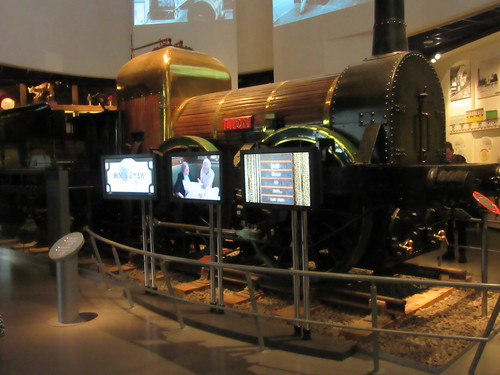 Museum of Liverpool: 'Lion'.
Museum of Liverpool: 'Lion'.
My introduction to 'Lion' and the activities of OLCO is here. All my posts about 'Lion' and OLCO activities can be found here.
OLCO has its own website dedicated to 'Lion' and models of 'Lion' here.
The Museum of Liverpool website has a page on 'Lion' here which includes links to two video interviews, 'Lion's Story' (with the Museum's Curator of Land Transport Sharon Brown) and 'Lion takes centre stage' (with two Officers from the Old Locomotive Committee, John Hawley the Magazine Editor and, ahem, Jan Ford the Secretary). 'Lion takes centre stage' is also available to museum visitors on the display screens next to the exhibit by pressing a button.
There's a short post on the making of 'Lion takes centre stage' here, more about the Museum of Liverpool and the way 'Lion' is displayed in the post Royal Visit to the Museum of Liverpool and a brief description of the complex Audio Visual Installations at the Museum here.
It's a great Museum and there were plenty of visitors enjoying the displays but I'm not a fan of the museum's modern architecture. Having checked that all appeared to be well with 'Lion', I walked to the nearby Mersey Ferry Building (another ghastly, modern affair) to board the next ferry.
 The Museum of Liverpool.
The Museum of Liverpool.
'Ferry cross the Mersey'
I was surprised at how many passengers were queuing for the eleven o'clock sailing, operated by the ferry 'Snowdrop', still in her 'DAZZLE' paint scheme I complained about in an earlier post here. The river was like a millpond, there was no wind and the sun beamed down on us as we made our crossing to Seacombe ferry terminal. It was such a glorious day, I decided to disembark at Seacombe and walk along the Promenade to New Brighton.
On Foot to New Brighton
The promenade from Seacombe to New Brighton looked inviting in the unexpected sunshine. There were a number of rod and line fishermen engaged in their hobby, together with joggers, dog-walkers, bicycles and casual walkers. There was the atmosphere of a seaside resort and, although Liverpool north docks were clearly visible on the opposite bank of the river, they didn't seem obtrusive.
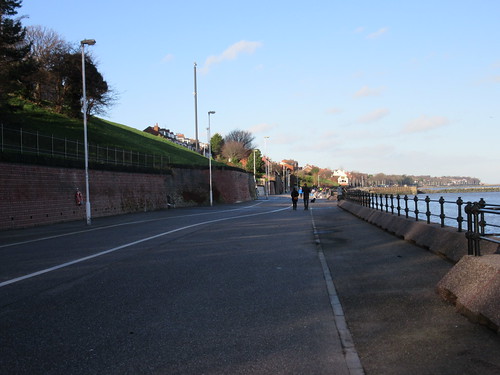 The Wirral: The start of the Promenade from Seacombe to New Brighton.
The Wirral: The start of the Promenade from Seacombe to New Brighton.
After passing the imposing bulk of Wallasey Town Hall (there's an article on its history here), I came to the traditional public house called 'The Ferry' at Egremont. In the picture below, you can see the first five massive new red-painted container cranes of the new 'Liverpool 2' port facility.
 The Wirral: The Promenade from Seacombe to New Brighton at Egremont, looking seawards.
The Wirral: The Promenade from Seacombe to New Brighton at Egremont, looking seawards.
Egremont is also the location of Captain's View which not only has a first floor apartment you can rent but is the site of one of the Wirralcam web cameras.
Using the 'Wirralcam' site, you can observe shipping on the Mersey from anywhere in the world. Supplement the pictures with ship data and position information on the River Mersey page from Ship AIS and you have an addictive 'virtual reality'.
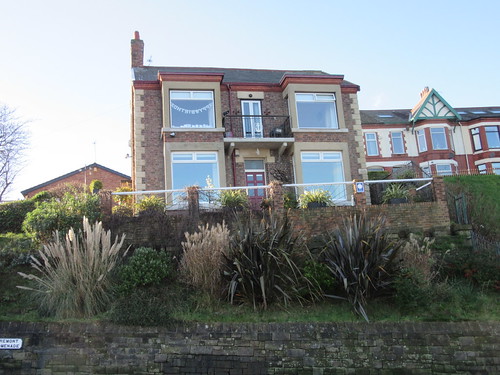 The Wirral: 'Captain's View', Egremont, viewed from the Promenade from Seacombe to New Brighton.
The Wirral: 'Captain's View', Egremont, viewed from the Promenade from Seacombe to New Brighton.
As I continued walking, I watched two tugs assisting a bulk carrier which was leaving the north docks stern-first. If you're interested, a telescope, binoculars (or the 'zoom' on a modern camera) can show a lot of detail.
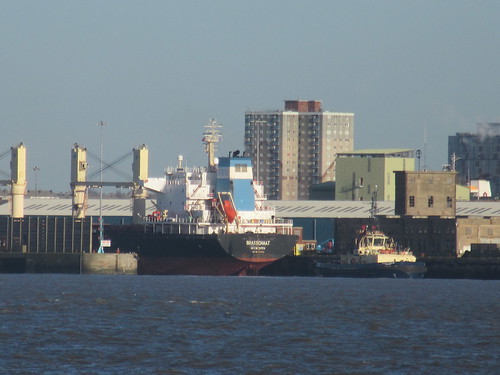 Liverpool Docks: Bulk Carrier 'Brasschaat' leaves the docks, stern first, assisted by two tugs.
Liverpool Docks: Bulk Carrier 'Brasschaat' leaves the docks, stern first, assisted by two tugs.
As I continued, I passed the War Memorial for World War I which faces the river.
1914 - 1919
TO THE GLORY OF GOD
AND IN HONOUR OF THE
BRAVE MEN OF THIS BOROUGH
WHO SERVED IN THE GREAT
WAR AND TO THE LOVING
MEMORY OF THOSE WHO
MADE THE SUPREME SACRIFICE
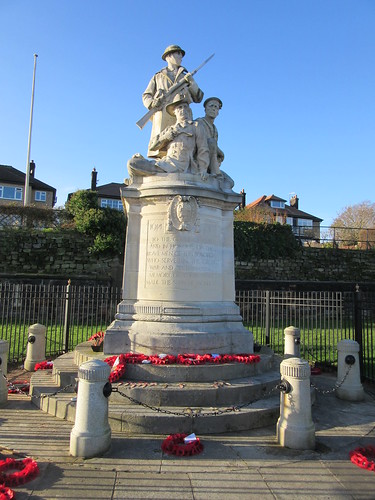
The Wirral: War Memorial 1914-1919 on the Promenade from
Seacombe to New Brighton.
Once having released her tugs, I was surprised at the speed with which 'Brasschaart' (operated by Sobelmar, Antwerp) headed for the Irish Sea. The picture below shows one of the two tugs posed in front of the Liverpool Bulk Terminal (briefly described in my post On foot around Liverpool Docks (3).
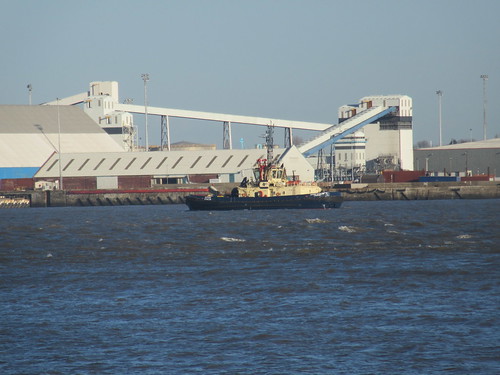 Liverpool Docks: Tug 'Svitzer Stanlow' after assisting 'Brasschaat', with Bulk Materials Storage conveyors in the background.
Liverpool Docks: Tug 'Svitzer Stanlow' after assisting 'Brasschaat', with Bulk Materials Storage conveyors in the background.
Quite unexpectedly, I came upon a 'pirate ship' made out of driftwood by 'PIRATES AT ART' (geddit?). I'm normally immune to Art Installations but I found the 'Black Pearl' charming. I saw a number of parents watching their children as they went inside the hull and climbed up to the deck. A very gentle 'Health and Safety' warning was posted on the promenade.
PIRATES AT ART want you to enjoy this Art installation. As it is an open access piece of work we ask you to take responsibility for yourself and those in your care. Please supervise your children at all times.
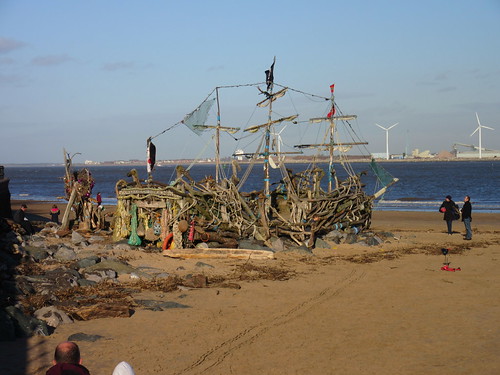 'The Black Pearl' New Brighton.
'The Black Pearl' New Brighton.
As I approached New Brighton, the size of the five massive new red-painted container cranes across the river at the 'Liverpool 2' terminal became more apparent. With the booms horizontal (as in the picture below) each stands over 300 feet tall and weighs 1600 tonnes. What I find more amazing is that all five cranes arrived fully assembled carried on a single ship 'Zhen Hua 23' after a 18,000 mile journey from Shanghai. The arrival, in November 2015, is described in SHIP-TO-SHORE CRANES ARRIVE.
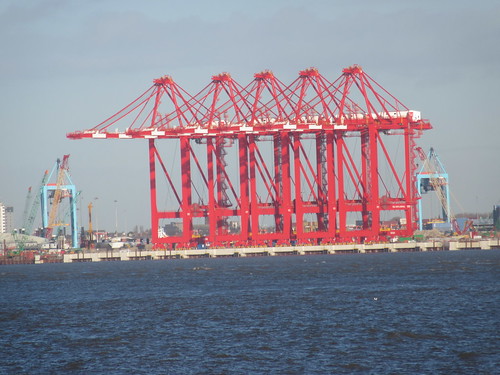 Liverpool Docks: The first five Container cranes at 'Liverpool 2'.
Liverpool Docks: The first five Container cranes at 'Liverpool 2'.
By the time I reached Fort Perch Rock, I decided I'd nearly had enough walking, so I walked inland along Victoria Road towards the railway station.
 New Brighton: Fort Perch Rock, with the lighthouse in the background.
New Brighton: Fort Perch Rock, with the lighthouse in the background.
By rail to Hamilton Square
On the way to the station, I paused at a Fish and Chip shop to buy a can of soft drink and a very generous portion of chips. I soon reached the railway station and managed to finish my chips before boarding the electric train to Birkenhead Hamilton Square. There's a little about this line and its origins here.
'Resurgam'
A short walk took me from the station to the Woodside Ferry Terminal. With a few minutes in hand before the arrival of the ferry to Liverpool, I decided to have a better look at the replica of an early submarine displayed outside the terminal. It is a full-size replica of 'Resurgam' built by trainees of Rathbone C.I. in 1997.
The Rathbone family were merchant traders with a social conscience who were founding members of the Liverpool Committee for the Abolition of Slavery. Rathbone C.I. was formed in 1995 by a merger of Rathbone educational charity work with a similar charity - Community Industry.
A brass plate on the replica gives a brief history of the original vessel:-
RESURGAM
Built in 1879 by J. T. Cochrane, Cleveland Street, Birkenhead
Designed by Reverend George Garrett (1852-1902)
"RESURGAM" - Latin for "I shall rise again"
This is a full-size model of one of the first submarines ever built. She was designed by Reverend George Garrett, a curate in Birkenhead who was a trained chemist. The construction was of iron and wood, 45 feet (14m) long, 10 feet (3m) in diameter and weighing 330 tons; she cost £1,538 to build. She was powered by a closed cycle steam engine and crewed by 3 men.
Trials in the East Float of Birkenhead Docks and at sea showed that she did sail and submerge, if only briefly. This was the first vessel to be successfully propelled mechanically underwater.
On her way to Portsmouth for a demonstration to the Royal Navy in February 1880, she sank in a storm 15 miles off Rhyl. The wreck was only found in 1995.
The model was built by AMARC trainees in 1997 and was refurbished in 2009 by the Maritime & Engineering College North West, Monks Way, Birkenhead.
There's more information in the Wikipedia article Resurgam.
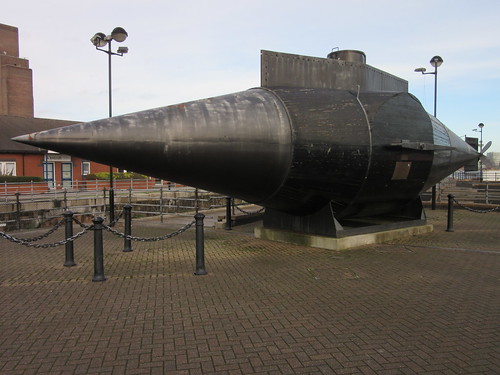 Replica of 'Resurgam' outside Woodside Ferry Terminal.
Replica of 'Resurgam' outside Woodside Ferry Terminal.
By Ferry to Pierhead
The ferry 'Snowdrop' arrived as scheduled from Seacombe but it took a short while to tie-up as a wind had started up and the river was far more lively than on my earlier crossing.
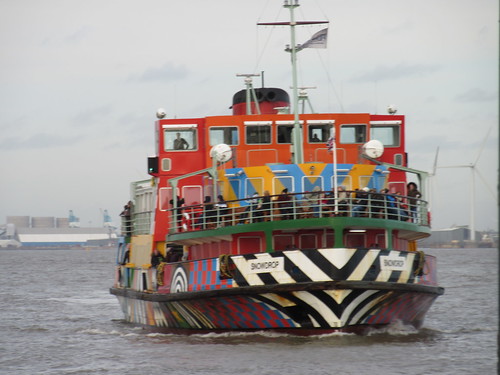 Birkenhead: 'Snowdrop' approaching Woodside Ferry Terminal.
Birkenhead: 'Snowdrop' approaching Woodside Ferry Terminal.
The short trip back to Liverpool gave views of the Cammell-Laird Shipyard (website here) and RFA 'Fort Austin' which I believe arrived on the 29th June 2015. She is one of two Fort-class 'Solid Support Ships' (formerly called 'Fleet Replenishment Ships'). On 8th February 2014 I'd seen her sister-ship 'Fort Rosalie' in the Cammell-Laird Ship Repair Site in Birkenhead's West Float (reported here).
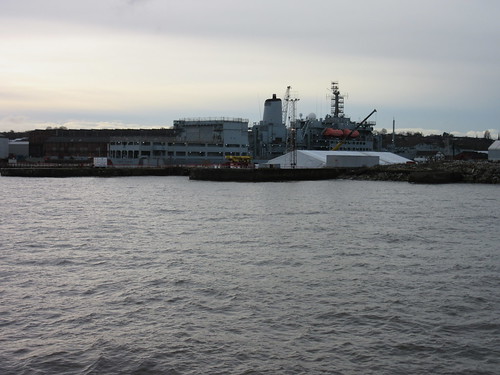 Birkenhead: RFA 'Fort Austin' in Cammell-Laird Shipyard.
Birkenhead: RFA 'Fort Austin' in Cammell-Laird Shipyard.
Beyond 'Fort Austin', I saw 'Go Pegasus' which forms part of the fleet of Singapore-based Otto Marine. Constructed at Otto Marine's Batam yard in Indonesia, 'Go Pegasus' is Norwegian designed and DNV-classed as an Anchor Handling Tug Supply (AHTS) vessel. With a 24,000 b.h.p. power unit, it is suitable for work in harsh environments and is equipped with Dynamic Positioning 2 (DP2) capabilities. Dynamic Positioning is described in a Wikipedia article here. DP1 systems are essentially simplex, DP2 are dual-redundant with voting for higher reliability and DP3 uses three sytems with other features. There's a graphic comparison of the system layouts in a Marine Technologies PDF here.
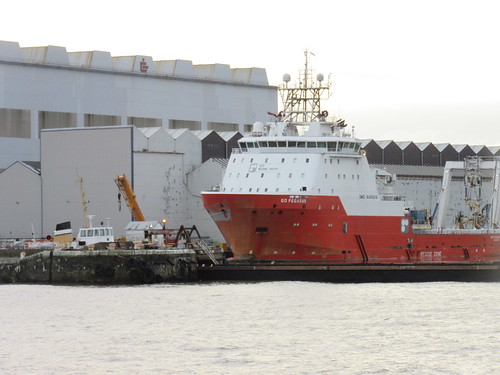 ' 'Go Pegasus' in the Cammell-Laird Shipyard.
' 'Go Pegasus' in the Cammell-Laird Shipyard.

This aerial view of the shipyard appeared on the Cammell-Laird site.
Whilst my attention was drawn to the shipyard, I hadn't noticed that we were being overhauled by a tanker heading upstream, probably to Stanlow. 'Stolt Redshank' (registered in Cardiff) is one of a large fleet of regional tankers, all named after birds, operated by Stolt-Nielsen Inter-Europe Service. This regional operation is part of the larger company Stolt-Neilsen Limited, founded by Jacob Stolt-Neilsen (1931-2015) in 1959 with one chartered ship.
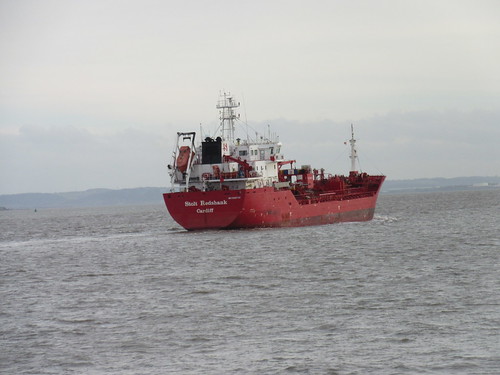 'Stolt Redshank' heads upstream.
'Stolt Redshank' heads upstream.
As our ferry manoeuvred towards Pierhead, another tanker heading upstream passed us. 'Aragonith' is an oil/chemical tanker operated by 'UNIBALTIC', a shipping company set up in Poland is 2003 with an informative website here with details of its fleet, including 'Aragonith'.
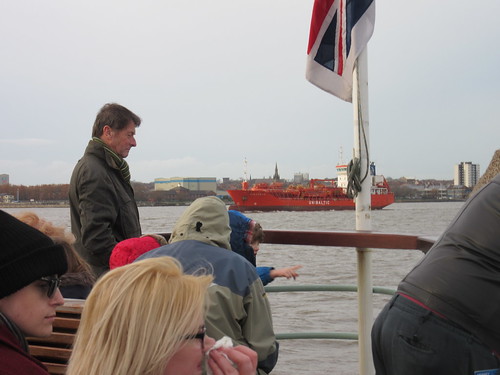 'Aragonith' heads upstream as 'Snowdrop' approaches Pierhead.
'Aragonith' heads upstream as 'Snowdrop' approaches Pierhead.
Homeward Bound
By the time I'd disembarked from 'Snowdrop', I thought I'd had sufficient exercise so I walked to James Street station and caught the next electric service to Lime Street. I was in good time for the hourly 'London Midland' service to Birmingham so I headed for home after an interesting (if tiring) trip.
Related posts on this website
There are all sorts of posts about Merseyside including:-
Birkenhead and New Brighton by train (Part 1).
Day Trip to Southport and Liverpool (Part 2).
More Merseyrail.
On foot around Liverpool Docks.
Preston to Liverpool by Rail.
My pictures around Merseyside
Liverpool.
Liverpool Docks.
Birkenhead and its Docks.
The Wirral.
New Brighton.
Liverpool area rail.
Merseyrail.
[Link to Cammell Laird updated: 7-Feb-2017]
 Wolverhampton Station.
Wolverhampton Station.
 Coulsdon South Station.
Coulsdon South Station.
 Bridge carrying the Brighton main line viewed from the road approach to Coulsdon South Station.
Bridge carrying the Brighton main line viewed from the road approach to Coulsdon South Station.
 The rebuilt terminal platforms at London Bridge viewed from my arriving train.
The rebuilt terminal platforms at London Bridge viewed from my arriving train.
 'Wavy' umbrella roofing on the terminal platforms at London Bridge.
'Wavy' umbrella roofing on the terminal platforms at London Bridge.
 The new concourse at London Bridge.
The new concourse at London Bridge.
 Selhurst Depot viewed from the Up London Bridge Fast.
Selhurst Depot viewed from the Up London Bridge Fast.
 Tulse Hill South Junction, viewed from a train on the Up West Norwood Spur. The Portsmouth lines are in the centre, with the Leigham Spurs (leading to Balham) curving away to the right.
Tulse Hill South Junction, viewed from a train on the Up West Norwood Spur. The Portsmouth lines are in the centre, with the Leigham Spurs (leading to Balham) curving away to the right.
 View from London Blackfriars station, looking upriver, with Charing Cross station in the centre.
View from London Blackfriars station, looking upriver, with Charing Cross station in the centre.
 St. Pancras International.
St. Pancras International.
 Euston: View from platform 7 looking towards Camden bank.
Euston: View from platform 7 looking towards Camden bank.



























































